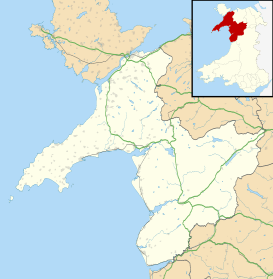Fort Belan
| Fort Belan | |
|---|---|
 | |
 Location within Gwynedd | |
| General information | |
| Location | Dinlle Peninsula, Llanwnda |
| Town or city | Gwynedd |
| Country | Wales |
| Coordinates | 53°07′21″N 4°19′58″W / 53.12239°N 4.33269°W |
| Completed | 1775 |
| Cost | £30,000 |
| Design and construction | |
| Architect | Thomas Wynn, 1st Baron Newborough |
Fort Belan (alternative: Belan Fort; pronounced: Bell-ann)[1] is a coastal fortress in North Wales. It is located opposite Abermenai Point, at the south-western end of the Menai Strait, on the coast of Gwynedd, in the parish of Llanwnda. Situated at the tip of the Dinlle Peninsula, the windblown, north-westernmost point of the Welsh mainland, the fort is cut off twice a day by the incoming tide.[1] Of geographic importance because of its location, Fort Belan is the access point to both the north Wales coast and to Liverpool, England. It is said to have cost £30,000 to build the fort.[2]
History
The fort was built in 1775 for a reported cost of £30,000[3][4] (£3,451,642 as of 2015),[5] by Thomas Wynn, then MP for Caernarfonshire and later to become Lord Newborough. He was worried about the vulnerability of Britain’s coastline to attack, particularly because of the ongoing American War of Independence. Fort Belan was the only purpose-built fort of the American Revolution on the eastern side of the Atlantic Ocean.[6] It guards a narrow passage of 35 m (115 ft) width.[7]

In the late 1780s, the barracks were used to ward off raiding American privateers from the Irish Sea. But despite its military history, "no shots have been fired in anger from the fort". In the 1820s, the Wynn family turned it into a private fort for themselves, adding a small harbour for Spencer Wynn's steam yacht. Major construction works took place between 1824 and 1826.[8] The watchtower was built in the 1890s by Freddie Wynn, and it housed a telescope.[9]
In 1907, Sir Ralph Frankland-Payne-Gallwey described seeing a dock, workshops for repairing vessels, marine storehouses, winches, and cranes.[2] During World War II, the fort was again used for military purposes as the base for the Home Guard and two rescue launches. In the 1950s it was owned by Colonel Robert Vaughan Wynn.[10] The Wynn family sold the property in 1992 to the Blundells as a base for marine biology exploration.[6][9] In 1996 the fort was reclassified as a Grade I listed building.[6][11]
Architecture

The fort's innermost buildings are slightly taller than the 20-foot (6.1 m) stone walls. In the centre of the fort is a sheltered quadrangle; at one time, there were peacocks here. Fortified towers are located at either end of the courtyard. Each of the towers displays the two-headed eagle of the first Lord Newborough. Small two-storey houses that were used as officer and privates' quarters line the flanks,[1] commodious barracks for the Caernarvonshire county militia.[12] Approximately 24 cannons form a gun battery along the walls. One of the inner corridors is said to be the haunt of a phantom nursemaid.[1]
Present use
Fort Belan formerly housed a maritime museum and a pottery.[13] It has been re-purposed as a self-catering holiday complex. The houses have been given a farmhouse feel and coal fires keep them warm. Notable overnight guests include Princess Margaret for the investiture of Prince Charles in 1969.[1]
References
- 1 2 3 4 5 Middleton, Christopher (5 Mar 2001). "Wales: Fortified by silence". The Daily Telegraph. London: The Daily Telegraph. Retrieved 8 September 2010.
- 1 2 Bindoff, Stanley T.; Roskell, John S.; Namier, Lewis (1982). The House of Commons: 1509–1558; 3, Members N - Z. 4. Boydell & Brewer. p. 671. ISBN 0-436-30420-1.
- ↑ The House of Commons: 1509 - 1558 ; 3, Members N - Z, Volume 4. Boydell & Brewer. 1982. p. 671. ISBN 0-436-30420-1.
- ↑ Headley, Gwyn; Meulenkamp, Wim (1986). Follies: A National Trust Guide. Cape. ISBN 0-224-02105-2.
- ↑ UK CPI inflation numbers based on data available from Gregory Clark (2016), "The Annual RPI and Average Earnings for Britain, 1209 to Present (New Series)" MeasuringWorth.
- 1 2 3 "A Short History of Fort Belan". fortbelan.co.uk. Retrieved 8 September 2010.
- ↑ "'FORT' BELAN?". fsgfort.com. Retrieved 8 September 2010.
- ↑ "Fort Belan Dockyard, Llandwrog". British Listed Buildings. Retrieved 8 September 2010.
- 1 2 "Friends' bid to restore Fort Belan watchtower". BBC. 17 June 2010. Retrieved 8 September 2010.
- ↑ Shaw, H. R. (1951). Country heritage: the stately homes of the north west counties and north Wales. Liverpool Daily Post and Echo limited.
- ↑ "Full Report for Listed Buildings". CADW. 30 September 1999. Retrieved 13 September 2016.
- ↑ Lewis, Samuel (1833). A topographical dictionary of Wales: comprising the several counties, cities, boroughs, corporate and market towns, parishes, chapelries, and townships, with historical and statistical descriptions : illustrated by maps of the different counties ; and a map of Wales, shewing the principal towns, roads, railways, navigable rivers, and canals ; and embellished with engravings of the arms of the cities, bishopricks, corporate towns, and boroughs ; and of the seals of the several municipal corporations ; with an appendix describing the electoral boundaries of the several boroughs, as defined by the late act. 2. Lewis and Co.
- ↑ Petersen, Duncan; Joyce Huber, Jon Huber (2000). Britain on Backroads. On Backroads Series. Hunter Publishing, Inc. p. 214. ISBN 1-55650-895-6.
External links
| Wikimedia Commons has media related to Fort Belan. |
Coordinates: 53°07′21″N 4°19′58″W / 53.12239°N 4.33269°W
